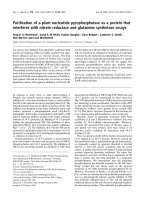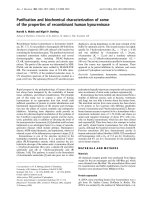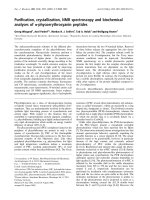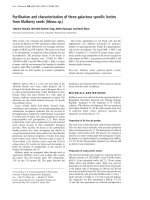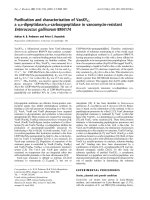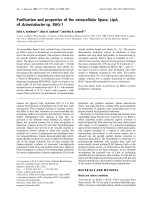Báo cáo Y học: Purification, characterization and subunits identification of the diol dehydratase of Lactobacillus collinoides pot
Bạn đang xem bản rút gọn của tài liệu. Xem và tải ngay bản đầy đủ của tài liệu tại đây (235.33 KB, 7 trang )
Purification, characterization and subunits identification of the diol
dehydratase of
Lactobacillus collinoides
Nicolas Sauvageot
1
, Vianney Pichereau
1
, Loı¨c Louarme
2
, Axel Hartke
1
, Yanick Auffray
1
and Jean-Marie Laplace
1
1
USC INRA de Microbiologie de l’Environnement, Universite
´
de Caen, France;
2
Chaire de Biochimie Industrielle et
Agro-Alimentaire, CNAM, Paris, France
The three genes pduCDE encoding the diol dehydratase of
Lactobacillus collinoides, have been cloned for overexpres-
sion in the pQE30 vector. Although the three subunits of the
protein were highly induced, no activity was detected in cell
extracts. The enzyme was therefore purified to near homo-
geneity by ammonium sulfate precipitation and gel filtration
chromatography. In fractions showing diol dehydratase
activity, three main bands were present after SDS/PAGE
with molecular masses of 63, 28 and 22 kDa, respectively.
They were identified by mass spectrometry to correspond to
the large, medium and small subunits of the dehydratase
encoded by the pduC, pduD and pduE genes, respectively.
The molecular mass of the native complex was estimated to
207 kDa in accordance with the calculated molecular masses
deduced from the pduC, D, E genes (61, 24.7 and 19,1 kDa,
respectively) and a a
2
b
2
c
2
composition. The K
m
for the three
main substrates were 1.6 m
M
for 1,2-propanediol, 5.5 m
M
for 1,2-ethanediol and 8.3 m
M
for glycerol. The enzyme
required the adenosylcobalamin coenzyme for catalytic
activity and the K
m
for the cofactor was 8 l
M
. Inactivation
of the enzyme was observed by both glycerol and cyano-
cobalamin. The optimal reaction conditions of the enzyme
were pH 8.75 and 37 °C. Activity was inhibited by sodium
and calcium ions and to a lesser extent by magnesium. A
fourth band at 59 kDa copurified with the diol dehydratase
and was identified as the propionaldehyde dehydrogenase
enzyme, another protein involved in the 1,2-propanediol
metabolism pathway.
Keywords: Lactobacillus collinoides; diol dehydratase;
purification; adenosylcobalamin; 1,2-propanediol.
Diol dehydratase (EC 4.2.1.28) and glycerol dehydratase
(EC.4.2.1.30) are two iso-functional enzymes that catalyse
the conversion of 1,2-propanediol, 1,2-ethanediol and
glycerol to propionaldehyde, acetaldehyde and 3-hydroxy-
propionaldehyde, respectively [1]. This dehydration reaction
is the first step of an anaerobic metabolism pathway. The
aldehyde produced by these dehydratases can then be
dismuted, allowing regeneration of NADH by an alcohol
dehydrogenase and/or the ATP synthesis involving CoA-
dependent propionaldehyde dehydrogenase, phosphotrans-
acylase and kinase [2]. These dehydratases have been widely
studied in bacteria such as Klebsiella pneumoniae [2,3],
K. oxytoca [4], Citrobacter freundii [5], Clostridium pasteu-
rianum [6] and Salmonella enterica LT2 [7]. They use
adenosylcobalamin (AdoCbl) as a cofactor and exhibit a
a
2
b
2
c
2
structure, where a, b and c represent the large,
medium and small subunits of the protein, respectively.
However, these two enzymes differ in their substrate
specificities since diol dehydratase has a higher affinity for
1,2-propanediol and glycerol dehydratase for glycerol [8].
Except for the microorganisms mentioned above, the
function of these enzymes in other bacteria is not well
understood. Despite the fact that the presence of diol and
glycerol dehydratases has already been reported in the
genera Lactobacillus [9,10], researchers have only recently
started to study these enzymes [11,12]. In Lactobacillus
reuteri, a bacterium resident of the gastrointestinal tract of
humans, the AdoCbl-dependent glycerol dehydratase has
been purified. This enzyme seemed to exhibit a particular
structure of four identical subunits of 52 kDa each [13]. Up
to now, this is the only communication of the composition
of a dehydratase enzyme obtained by purification in this
bacterial genera.
L. collinoides is a lactic acid bacterium commonly
encountered in cider [14], in which it may be responsible
for the alteration known as Ôpiqu
ˆ
re acrole
´
iqueÕ, as a result of
the formation of acrolein (2-propenal), a lachrymatory
chemical generating a peppery flavour [15]. Acrolein is not
issued from the bacterial metabolism but rather is in
chemical equilibrium with 3-hydroxypropionaldehyde
formed by the dehydratase from glycerol. This aldehyde
can spontaneously form acrolein by thermal dehydration
under acid or heat conditions thus spoiling the quality of
cider.
During the course of our investigations on the glycerol
metabolic pathway in L. collinoides, we have sequenced a
genomic DNA region exhibiting strong homologies with the
diol dehydratase pdu operon of Salmonella enterica [16]. The
structure of the protein deduced from this sequence was
Correspondence to N. Sauvageot, USC INRA de Microbiologie
de l’Environnement, Universite
´
de Caen, 14032 CAEN Cedex, France.
Fax: + 33 2 31 56 53 11, Tel.: + 33 2 31 56 59 30,
E-mail:
Abbreviations: AdoCbl, adenosylcobalamin; CNCbl,
cyanocobalamin.
Enzymes: Diol dehydratase (EC 4.2.1.28); glycerol dehydratase
(EC.4.2.1.30).
(Received 21 June 2002, revised 25 September 2002,
accepted 2 October 2002)
Eur. J. Biochem. 269, 5731–5737 (2002) Ó FEBS 2002 doi:10.1046/j.1432-1033.2002.03288.x
different than that reported in L. reuteri. In this study, we
report the purification, enzymatic characterization and
analysis of the composition of the diol dehydratase of
L. collinoides.
MATERIALS AND METHODS
Bacteria and culture conditions
The lactic acid bacterium used in this study was L. collino-
ides LMG 18850, isolated from a French cider [17]. Cultures
were grown in MRS medium [18] supplemented with 2%
(w/v) glucose at 30 °C without shaking. For the purification
of the diol dehydratase, L. collinoides was grown in 3 L
conical flasks containing 2.5 L MRS medium supplemented
with 50 m
M
1,2-propanediol and 15 m
M
glucose. After
inoculation with 2% (v/v) of a 48-h culture of L. collinoides,
the conical flask was incubated for 20 h at 30 °C. The
Escherichia coli M15[pREP4] strain (Qiagen, Santa Clara,
CA, USA), used for the overexpression, was cultured under
the manufacturer’s recommended conditions, in 2 · TY
medium [19] with 100 lgÆmL
)1
ampicillin and 25 lgÆmL
)1
kanamycin.
Purification procedures
Cellular lysis. The protocol for the purification of the diol
dehydratase of L. collinoides was adapted from that of
Schu
¨
tz and Radler [20]. Cells were harvested by centrifuga-
tion (3000 g, 10 min) and washed twice in potassium
phosphate buffer K
2
HPO
4
I(10m
M
,pH7.2,1m
M
dithiothreitol and 1 m
M
phenylmethanesulfonyl fluoride)
and suspended in 10 mL of degassed K
2
HPO
4
II (10 m
M
,
pH 7.2 containing 5 m
M
of dithiothreitol). The lysis was
performed by one passage through the Ôone shotÕ cell
disrupter (ConstantSystem, Northants, UK) at 2.15 kbar.
1 mg of deoxyribonuclease I (Sigma, St Louis, MO, USA)
was added to the disrupted solution and cell debris were
removed by two centrifugations (3000 g,10minand
15 500 g,20min).
Ammonium sulfate precipitation. The extract was homo-
genized with 1 volume of ammonium sulfate solution at
456 gÆL
)1
to obtain a final concentration of 40% saturation.
The homogenate was maintained on ice for 1 h and
centrifuged for 20 min at 15 500 g. The pink sediment (C40)
containing the diol dehydratase was resuspended in 1 mL of
the K
2
HPO
4
II buffer described above.
Gel filtration chromatography. The preparation was
loaded onto a Sephacryl S300H (Sigma) column
(100 · 1.6 cm) equilibrated with K
2
HPO
4
II. Chromato-
graphy was conducted at a flow rate of 0.6 mLÆmin
)1
and
fractions containing the highest dehydratase activity were
pooled and stored until use at )20 °C.
Dehydratase assays
Two methods were used for the determination of the
activity. During the purification and characterization
enzyme steps, the assay was carried out using the
3-methyl-2-benzothiazolinone hydrazone method [21].
The reaction mixture (0.5 mL) was composed of 0.2
M
1,2-propanediol (or glycerol), 0.05
M
KCl, 0.035
M
potas-
sium phosphate (pH 7.2) and 20 l
M
AdoCbl. The reaction
was proceeded for 10 min at 37 °C and stopped by addition
of 0.5 mL of 0.1
M
potassium citrate buffer (pH 3.6) and
250 lL of 0.1% 3-methyl-2-benzothiazolinone hydrazone
solution. After a 15-min incubation period at 37 °C, 0.5 mL
of water was added and the absorbance was measured at
305 nm.
The second procedure, used for the determination of
kinetic constants, was reported by Bobik et al.[7].The
aldehyde formation was coupled with the alcohol dehy-
drogenase (Roche Diagnostics, Mannheim, Germany).
A 1-mL reaction mixture contained 0.1
M
1,2-propanediol,
0.1
M
Hepes buffer (pH 8.75), 0.1 m
M
NADH, excess
alcohol dehydrogenase (18 U) and 20 l
M
AdoCbl. The
1,2-propanediol utilization was monitored by following the
conversion of NADH to NAD
+
at 340 nm. For the K
m
determination with glycerol, assays were performed as
described above but without NADH and alcohol dehy-
drogenase since the 3-hydroxypropionaldehyde was not
converted to 1,3-propanediol by the alcohol dehydrogenase.
The reaction was stopped after 0, 2, 4 and 6 min with 1
volume of 1
M
citrate buffer (pH 3.6) and the 3-hydroxy-
propionaldehyde was monitored using the 3-methyl-
2-benzothiazolinone hydrazone method. One unit of diol
dehydratase activity was defined as 1 lmol of aldehyde
formed per minute. For the assays, between 0.001 and 0.01
units of enzyme were used. Protein concentration was
determined by the method of Lowry [22] with BSA as a
standard.
PAGE
PAGE under denaturing conditions was performed as
described by Laemmli [23] in the MiniProtean(R)3 appar-
atus (Bio-Rad, Hercules, CA, USA) with a 12% polyacryl-
amide gel. A 6% polyacrylamide gel without SDS was used
for electrophoresis under nondenaturing conditions. Pro-
teins were stained with Coomassie Brilliant Blue R250.
Trypsin digestion and mass spectrometry
Bands of interest were excised from the gel, rinsed twice with
ultra pure water and dehydrated for 10 min by incubation
in acetonitrile (Sigma). Samples were dried for 30 min under
vacuum and reswelled with 2 lLof50m
M
NH
4
HCO
3
containing 1 lg of trypsin for 1 h. Twenty microliters of
50 m
M
ammonium bicarbonate were added and digestion
was continued overnight. After centrifugation (1000 g,
5 min), the supernatant was collected and gel pieces were
placed successively in 20 lLof20m
M
ammonium bicar-
bonate, 20 lLof20m
M
ammonium bicarbonate/acetonit-
rile (1 : 1, v/v), twice in 5% formic acid/acetonitrile (1 : 1,
v/v) and finally 20 lL of acetonitrile. Samples were
centrifuged between each step and supernatants were
collected, pooled, dried and resuspended in 10 lLof0.1%
formic acid in ultra pure water.
An electrospray ion trap spectrometer (LCQ DecaXP,
ThermoFinnigan, San Jose, CA, USA) coupled on line with
HPLC (SurveyorLC) was used for peptides analysis.
Peptides were separated by reversed-phase HPLC on a
C
18
capillary column (ThermoHyPurity C18 150 · 0.18).
A linear 18-min gradient (flow rate, 3 lLÆmin
)1
)from5to
5732 N. Sauvageot et al. (Eur. J. Biochem. 269) Ó FEBS 2002
80% B was used, where solvent A was 0.1% aqueous formic
acid and solvent B was 0.1% formic acid in acetonitrile. The
electrospray ionization parameters were as follows: spray
voltage, 3.5 kV; sheath gas flow rate, 30; capillarity
temperature, 200 °C; capillarity voltage, 30 V; Tube lens
offset, 35 V. Mass spectrometry were acquired in a mode
that alternated a full MS scan (mass range: 400–1600) and a
collision induced dissociation tandem mass spectrometry
(MS/MS) of the most abundant ion. The collision energy
for the MS/MS scan was preset at the value of 35%. Data
were analysed using the
SEQUEST
algorithm (version 2)
incorporated with the ThermoFinnigan
BIOWORKS
software
(version 2).
Cloning of the
pduCDE
genes and overexpression
DNA manipulation techniques were performed according
to Sambrook et al. [19]. The three diol dehydratase genes
were ligated into the expression vector pQE30 (Qiagen)
downstream the His-tag sequence (pQE30HisDD). E. coli
M15[pREP4] was used as the host strain. The absence of
undesired mutation was confirmed by sequencing using the
dideoxy chain-termination method [19] with the ABI Prism
sequencing system (PE Biosystem, Warrington, UK).
Transcription was induced by addition of isopropyl b-
D
-
thiogalactoside to a final concentration of 1 m
M
for 4 h.
The His-tag removal was obtained from the previous
construction. The new construction (pQE30DD) contained
the sequence of the a, b and c subunits genes and their Shine
Dalgarno sequences.
RESULTS
High-level expression of the
L. collinoides
diol
dehydratase
The three genes pduCDE encoding the three subunits of the
diol dehydratase were cloned in the pQE30 expression vector
system. The synthesis of the three subunits of the protein was
controlled by SDS/PAGE (Fig. 1A). Despite the high level
of synthesis of the three proteins at 61, 24.7 and 19.1 kDa,
no activity was detected in the extracts even using the same
extraction protocol that detects activity in L. collinoides.A
new attempt was performed with a new construction
(pQE30DD) in which the His-tag coding sequence was
removed. However, no dehydratase activity was detectable
even with addition of 1,2-propanediol, Brij35 (detergent
compatible with activity [24]), or by reducing the induction
period or induction temperature (data not shown). To
determine if the three subunits of the enzyme were expressed
in a soluble form or in inclusion bodies, an SDS/PAGE
analysis of the soluble and insoluble fractions was performed
(Fig. 1B). The subunits of the diol dehydratase, mainly the
medium subunit, were present in the insoluble fraction
suggesting that the recombinant protein cannot form an
active complex. In order to demonstrate that the three genes
pduCDE encode for active diol dehydratase, we attempted to
purify the enzyme from L. collinoides.
Purification of the diol dehydratase of
L. collinoides
Unliketheentericbacteria,L. collinoides was unable to
grow on 1,2-propanediol as the sole carbon source.
Recently, we have shown that a high level of activity was
detected during the stationary phase when this microorgan-
ism was grown in MRS medium containing 15 m
M
glucose
and 50 m
M
1,2-propanediol [16]. Therefore, these growth
conditions were used in order to purify the diol dehydratase
enzyme.
As reported by Talarico et al. [13] for the glycerol
dehydratase of L. reuteri, the enzyme of L. collinoides was
stable in media containing high potassium and 1,2-pro-
panediol concentrations. A first purification was attempted
with a phosphate buffer containing these two compounds.
However, under these conditions, the enzyme started to
precipitate at very high ammonium sulfate concentration
(70% saturation) and the yield of active enzyme was very
low. For this reason, we have purified the enzyme in a
10-m
M
potassium phosphate buffer without 1,2-propane-
diol and potassium. Under this condition, the enzymatic
complex was very unstable at 4 °C. Ninety percent of the
activity was lost during 5 days storage (data not shown).
The different steps of the purification of the diol dehydra-
tase of L. collinoides are summarized in Table 1.
The first step was a precipitation with ammonium sulfate.
The enzyme precipitated between 20 and 60% saturation
with a maximum specific activity at 40% saturation. A first
strategy based on stepwise ammonium sulfate precipitation
(step 20% followed by 60% saturation) resulted in complete
loss of activity. Thus, the dehydratase was precipitated with
40% ammonium sulfate. The sample was loaded onto a
Sephacryl S300H chromatography. The activity eluted from
the column 28 mL after the void volume. The six fractions
Fig. 1. SDS/PAGE of cell-free extracts of E. c oli showing the over-
expression (A) and insolubility (B) of the three genes pduCDE coding for
the diol dehydratase of L. collinoides. (A) Protein content of E. coli
M15[pREP4] carrying the plasmid pQE30 (control, lane 1),
pQE30HisDD (lane 2) and pQE30DD (lane3) after induction with
1m
M
isopropyl b-
D
-thiogalactoside and 4 h incubation. (B) Protein
content of E. coli M15[pREP4] carrying the plasmid pQE30 (control,
lanes 4,5,6), pQE30HisDD (lanes 7–9), total expression (lanes 4 and 7),
insoluble fraction (lanes 5 and 8) and soluble fraction (lanes 6 and 9).
Table 1. Purification of diol dehydratase of L. collinoides.
Purification
step
Protein
(mg)
Activity
(U)
Specific
activity
(UÆmg
)1
)
Yield
(%)
Purification
factor
Crude extract 129.34 28.68 0.22 100 1
C40 16.78 5.69 0.34 19.8 1.54
Sephacryl S300H 4.15 3.2 0.77 11.1 3.5
Ó FEBS 2002 Diol dehydratase purification and characterization (Eur. J. Biochem. 269) 5733
containing the maximal diol dehydratase activity were
combined and used for the characterization of the enzyme.
After Sephacryl S300H chromatography, the pooled
fractions containing the highest dehydratase activity were
analysed by SDS/PAGE. The pattern showed four main
bands with molecular masses of approximately 63, 59, 28
and 22 kDa (proteins 1, 2, 3 and 4, respectively) (Fig. 2).
The molecular masses of three of these bands (proteins 1, 3
and 4) were in good agreement with those calculated for the
polypeptides encoded by the pduCDE genes (60.1, 24.7 and
19.1 kDa for the a, b, c subunit, respectively). All bands
were excised from the gel, digested by trypsin, and their
identities were ascertained by mass spectrometry (Table 2)
with the help of the pduCDE nucleotide sequence. The three
bands at 63, 28 and 22 kDa were identified as PduC, PduD
and PduE, respectively.
Regarding the fourth band at 59 kDa (Protein 2), we first
supposed that it could represent the large subunit of the
reactivation factor of L. collinoides (PduG). Indeed, recent
studies have shown that the diol dehydratase of K. oxytoca
and the glycerol dehydratases of K. pneumoniae and
C. pasteurianum can form a complex with the reactivation
factor [25]. However, this hypothesis was disproved by mass
spectrometry analysis.
Among the various attempts to purify diol dehydratase,
the presence of a fourth band at 51 kDa has been reported
in K. oxytoca and microsequenced [26,27]. N-Terminal
sequence analysis revealed that it showed high homology to
CoA-dependent propionaldehyde dehydrogenase of S. ent-
erica PduP. By mass spectrometry analysis, nine short
polypeptides have been microsequenced; six of these exhibit
weak homologies with some dehydrogenases and one
fragment seemed to be related to the L. monocytogenes
and L. innocua propionaldehyde dehydrogenase. With the
help of the propionaldehyde dehydrogenase sequence of
L. collinoides (O. Claisse, University of Bordeaux, France,
personnal communication), we confirmed that the copuri-
fied protein corresponded to this enzyme (Table 2).
In order to determine if the fourth band belonged to the
enzymatic complex, two-dimensional electrophoresis was
performed (Fig. 3). The first dimension was carried out
under nondenaturing conditions and revealed one main
band and two weaker bands. Their dissociation by SDS in
the second dimension showed that the main band was
released into three subunits migrating at the same positions
as the large, medium and small subunits of the diol
dehydratase. However, the band of 59 kDa was not aligned
with the three Pdu proteins. Therefore, it seemed that the
fourth protein copurified with the diol dehydratase does not
belong to the dehydratase complex.
Characterization of the diol dehydratase
The molecular mass of the native dehydratase was estimated
by the Sephacryl S300H gel filtration using five standards of
known molecular mass (thyroglobulin 669 kDa, apoferritin
443 kDa, b-amylase 200 kDa, alcohol dehydrogenase
Fig. 3. Two-dimensional PAGE of purified diol dehydratase. After the
two-step purification, an aliquot containing dehydratase activity was
first separated on 6% nondenaturing polyacrylamide gels. The lane
was cut from the first gel and put on horizontally onto a 12% SDS
polyacrylamide gel. Proteins corresponding to PduCDE and to
the propionaldehyde dehydrogenase copurified are indicated. The
propionaldehyde dehydrogenase does not align with the three diol
dehydratase subunits (dashed line).
Table 2. Mass-spectrometric identification of the protein components
purified from SDS/PAGE.
Protein
number
Best
hit Score
a
MS/MS
sequenced
peptides
% Protein
coverage
b
1 PduC 274 17 37.3
2 Propionaldehyde
dehydrogenase
147 8 24.9
3 PduD 157 7 48.7
4 PduE 181 7 58.4
a
Represents the score given by the
SEQUEST
software and
b
the
percentage of amino acids effectively sequenced by LC-MS/MS.
Fig. 2. SDS/PAGE analysis of the purification steps of the diol dehy-
dratase from L. collinoides. Lane 1: molecular mass markers, lane 2:
crude extract, lane 3: ammonium sulfate precipitation C40, and lane 4:
pooled fractions from the Sephacryl S300H.
5734 N. Sauvageot et al. (Eur. J. Biochem. 269) Ó FEBS 2002
150 kDa and BSA 66 kDa) (Fig. 4) and was found to be
approximately 207 kDa.
The determination of the optimum pH for enzyme activity
was performed by using a range from pH 6 to pH 9.5 in
100 m
M
Hepes buffer adjusted with KOH. The highest
activity was obtained between 8.5 and 9.25 with a maximum
at pH 8.75. This was in accordance with the optimum pH of
the dehydratase of K. pneumoniae (pH 8.6) [28] but not with
the L. reuteri enzyme (pH 7.2) [13]. Temperature was also
studied for its influence on the 1,2-propanediol conversion to
propionaldehyde. A range of temperatures between 25 °C
and 45 °C was tested and the optimum was observed at
37 °C. So, further kinetic experiments were performed at
these pH and temperature values.
The K
m
for the three preferential substrates of the
dehydratase and the AdoCbl cofactor were determined. The
highest substrate affinity was obtained for 1,2-propanediol
with a K
m
of 1.6 m
M
followed by 1,2-ethanediol (K
m
:
5.5 m
M
) and glycerol (K
m
:9.4 m
M
). Affinity for the AdoCbl
coenzyme was considerably higher with a K
m
of 8.3 l
M
.
It has been shown that glycerol is both a substrate and a
suicide-inactivator for diol and glycerol dehydratase [8]. In
order to show whether the enzyme of L. collinoides posses-
ses this characteristic, a dehydration reaction time course
was performed with 1,2-propanediol or glycerol (Fig. 5A).
When 1,2-propanediol was used as substrate, a linear
increase in aldehyde formation was observed for 20 min. In
the case of glycerol, the initial kinetic was similar to that
found using 1,2-propanediol but the reaction ceased after
4 min. This could not be explained by exhaustion of the
substrate, which was present in excess (0.2
M
), and conse-
quently must have resulted from the inactivation of the
L. collinoides diol dehydratase.
Cyanocobalamin (CNCbl) is a competitive inhibitor of
diol and glycerol dehydratases and its effect on the enzyme
of L. collinoides was studied. Figure 5B illustrated the time
course reaction of L. collinoides diol dehydratase with 1,2-
propanediol as substrate and a AdoCbl/CNCbl mixture as
cofactor. In all kinetic experiments, AdoCbl was appointed
to 15 l
M
. No inhibition was observed when CNCbl was
absent. When increased concentration of CNCbl was
added, the formation rate of propionaldehyde decreased
reflecting the increased fixation of the inactive analogue of
the AdoCbl. A K
i
of 26.4 l
M
was calculated for the
cyanocobalamin.
For all the dehydratases characterized [2–7], monovalent
cations seem to be required for the catalytic activity. The
influence of various mono and divalent cations in low
concentrations (10 m
M
) on the diol dehydratase activity was
then studied (data not shown). A slightly inhibitory effect
was observed with the divalent Mg
2+
ion whereas both
sodium and calcium ions caused complete inhibition. The
potassium concentration estimated at pH 8.75 in the
reaction mixture was 100 m
M
. Therefore, the inhibitory
effect observed with Mg
2+
,Ca
2+
and Na
+
ions was not a
competitive inhibition but rather due to an alteration of the
complex. This effect was not observed with Li
+
and NH
4
+
,
which did not affect activity. All characteristics are
summarizedinTable3.
DISCUSSION
In cider, L. collinoides is involved in glycerol degradation
leading potentially to an alteration of the beverage known
as Ôpiqu
ˆ
re acrole
´
iqueÕ. The first reaction of the glycerol
Fig. 4. Gel filtration chromatography and molecular mass determination
of the diol dehydratase of L. collinoides. Proteins were separated on
Sephacryl S300H column and fractions containing diol dehydratase
were identified by activity determination. The molecular mass calib-
ration was performed with five standard proteins (d) (thyroglobulin
669 kDa, apoferritin 443 kDa, b-amylase 200 kDa, alcohol dehy-
drogenase 150 kDa and BSA 66 kDa).
Fig. 5. Time course of reaction of diol dehydratase with 1,2-propanediol
or glycerol (A) and the effect of CNCbl on the enzymatic activity with
0.2
M
of 1,2-propanediol as substrate (B). (A) The amount of aldehyde
formed was determined by the 3-methyl-2-benzothiazolinone hydra-
zone method with 0.2
M
of 1,2-propanediol (j)orglycerol(d)and
0.0015 U of enzyme. (B) Time course of reaction with 0.007 U of diol
dehydratase and 15 l
M
of AdoCbl plus 0 l
M
(j), 5 l
M
(e), 10 l
M
(n), 20 l
M
(s)and50l
M
(h)ofCNCbl.
Ó FEBS 2002 Diol dehydratase purification and characterization (Eur. J. Biochem. 269) 5735
metabolism is catalysed by a dehydratase that converts
glycerol to 3-hydroxypropionaldehyde, a precursor of
acrolein [12]. The dehydratase enzyme plays therefore a
key role in the development of the alteration in cider. Unlike
the enteric bacteria and C. pasteurianum, which are able to
grow on glycerol or 1,2-propanediol, L. collinoides can not
grow on media containing these compounds as the sole
carbon source. This strongly suggests an essential role for
the regeneration of NADH, which is necessary to reduce
3-hydroxypropionaldehyde to 1,3-propanediol by 1,3-pro-
panediol dehydrogenase. As the three genes encoding the
three subunits of the dehydratase have been sequenced [16],
the first strategy attempted to purify the enzyme was the
expression of recombinant protein in E. coli. Although the
three subunits were expressed, no activity could be detected.
In all heterologous expressions of others dehydratases, it has
been shown that no additional subunit was required for
activity [5–7]. A reasonable explanation for our result was
that the protein possesses a low solubility. This feature
seems to be common to dehydratases and the use of
detergents like Brij35 (0.5–1%) has been shown to increase
considerably the solubility [24]. However, this was not the
case for the diol dehydratase of L. collinoides.Asallthe
recombinant diol dehydratases, overexpressed and recov-
ered in an active form in E. coli, belonged to enterobacteria
(S. enterica, K. oxytoca and K. pneumoniae), it is possible
that an important compound for the formation of the
L. collinoides protein folding complex or enzyme activity
was lacking.
In the second attempt, we purified the enzyme from
crude extracts of L. collinoides by a two-step procedure.
This strategy allowed us to purify the enzyme to near
homogeneity and to increase the specific activity of the
preparation
8
. The decrease of the total activity was prob-
ably due to considerable enzyme instability during the
purification process. The diol dehydratase exhibited a
native molecular mass of the complex of 207 kDa. This
was in accordance with the masses obtained for other
dehydratases (180 kDa for L. brevis, 190 kDa for
C. pasteurianum, 230 kDa for K. oxytoca, 188 kDa for
K. pneumoniae). The enzyme was able to degrade the three
substrates tested and the specificities observed confirmed
that the enzyme belongs to the diol dehydratase family.
Although L. collinoides is known to be involved in an
alteration beginning with glycerol degradation, this latter
was not the preferred substrate.
9
The enzyme showed
highest affinity for 1,2-propanediol and 1,2-ethanediol.
Moreover, it was coenzyme AdoCbl-dependent and had a
strong affinity for the cofactor. The K
m
obtained was
similar to that obtained for the enzyme of L. brevis (7 l
M
)
[20]. The study of the effect of different cations on the
reaction showed that Na
+
and Ca
2+
were incompatible
with catalysis. This was probably due to a dissociation of
the complex as reported by Schneider et al.[3]forthe
glycerol dehydratase apoenzyme with Na
+
.
Contrary to the glycerol dehydratase of L. reuteri,which
has been reported to be a homotetramer of 52 kDa
subunits, the dehydratase of L. collinoides showed a classi-
cal heterotrimer conformation similar to that of other
described enzymes (K. oxytoca [4], K. pneumoniae [2,3],
S. enterica [7], C. freundii [5] and C. pasteurianum [6]).
However, since the enzyme of L. reuteri was purified with
two other proteins (70 and 40 kDa) and no genetic studies
have been published, one cannot eliminate the possibility
that the dehydratase of this organism is also composed of
several nonidentical subunits. Moreover, the copurification
of the propionaldehyde dehydrogenase together with diol
dehydratase observed in this work, has also been reported
by McGee in K. oxytoca [26,27]. Therefore in L. reuteri,we
can assume that the 52 kDa protein was incorrectly assigned
as a subunit of the diol dehydratase and is rather a
propionaldehyde dehydrogenase. It is interesting to note
that the protein copurified with the diol dehydratase belongs
to the same operon. However, as we showed, the propion-
aldehyde dehydrogenase does not seem to be a part of the
dehydratase.
Recently, parts of diol dehydratase operon have been
sequenced in L. hilgardii and L. diolivorans [29]. This
confirms the presence of a diol dehydratase exhibiting a
a
2
b
2
c
2
composition in the Lactobacillus genera.
In conclusion, we confirm here that the pdu operon
encodes the functional dehydratase enzyme of L. collinoides.
This suggests that the structure with three nonidentical
subunits protein represents the main model in the diol or
glycerol dehydratase in enterobacteria, C. pasteurianum as
well as in L. collinoides.
Table 3. Characteristics and comparison of the diol dehydratase of L. collinoides with the others Lactobacillus enzymes. Data for L. brevis, L. reuteri
and L. sp. 208 A are taken from [20] [13], and [10], respectively. p-CMB, p-chloromercuribenzoate, –, not determined.
Characteristics L. collinoides L. brevis L. reuteri L. sp. 208 A
K
m
1,2-propanediol (m
M
) 1.6 0.6 7 –
K
m
glycerol (m
M
) 8.3 4.0 3.3 –
K
m
1,2-ethanediol (m
M
) 5.5 5.3 – –
K
m
AdoCb (l
M
) 8 7 0.3 –
V
max
1,2-propanediol (UÆmg protein
)1
) 0.054 – – –
V
max
glycerol (UÆmg protein
)1
) 0.018 – – –
V
max
1,2-ethanediol (UÆmg protein
)1
) 0.012 – – –
Molecular mass (kDa) 207 180 200 188
Subunit composition a2b2c2 – Homotetamer –
Subunit molecular masses (kDa) 63, 25, 19 – 52 –
pH optimum 8.75 7.0–7.5 6.5–8 5.8–6.0
Temperature optimum (°C) 37 30–40 – –
Ion activity Na > Ca >Mg Na > Li > Mg > Mn – Na
Inhibitor CNCbl p-CMB CNCbl CNCbl
5736 N. Sauvageot et al. (Eur. J. Biochem. 269) Ó FEBS 2002
ACKNOWLEDGEMENTS
The authors wish to thanks the professor Jacques Nicolas, director of
the ÔChaire de Biochimie Industrielle et Agro-AlimentaireÕ of the
CNAM of PARIS for his welcome of Nicolas Sauvageot in his
laboratory. This work was partly supported by a grant from the Ôconseil
re
´
gional pour lÕAgrobiologie et la Bioindustrie (CRAB) de Basse-
Normandie’ and from the European Union. N. Sauvageot is the
recipient of an award from the Ministe
`
re de la Recherche et de
l’Enseignement Supe
´
rieur of France. We thank Mrs Monika
Dabrowski-Coton for correcting the manuscript and Mr Olivier Claisse
for providing us with the propionaldehyde dehydrogenase amino acid
sequence.
REFERENCES
1. Lee, H.A.J.R. & Abeles, R.H. (1963) Purification and properties
of dioldehydrase, an enzyme requiring a cobamide coenzyme.
J. Biol. Chem. 238, 2367–2373.
2. Toraya, T., Honda, S. & Fukui, S. (1979) Fermentation of
1,2-propanediol and 1,2-ethanediol by some genera of
Enterobacteriaceae, involving coenzyme B
12
-dependent diol
dehydratase. J. Bacteriol. 139, 39–47.
3. Schneider, Z., Larsen, E.G., Jacobson, G., Johnson, B.C. &
Pawelkiewicz, J. (1970) Purification and properties of glycerol
dehydrase. J. Biol. Chem. 245, 3388–3396.
4. Poznanskja, A.A., Tanizawa, K., Soda, K., Toraya, T. & Fukui, S.
(1979) Coenzyme B
12
-dependent diol dehydrase: purification,
subunit, heterogeneity, and reversible association. Arch. Biochem.
Biophys. 194, 379–386.
5. Seyfried, M., Daniel, R. & Gottschalk, G. (1996) Cloning,
sequencing and overexpression of the genes encoding coenzyme
B
12
-dependent glycerol dehydratase of Citrobacter freundii.
J. Bacteriol. 178, 5793–5769.
6. Macis, L., Daniel, R. & Gottschalk, G. (1998) Properties and
sequence of the coenzyme B
12
-dependent glycerol dehydratase
of Clostridium pasteurianum. FEMS Microbiol. Lett. 164,
21–28.
7. Bobik, T.A., Xu, Y., Jeter, R.M., Otto, K.E. & Roth. J.R. (1997)
Propanediol utilization genes (pdu)ofSalmonella typhimurium:
three genes for the propanediol dehydratase. J. Bacteriol. 179,
6633–6639.
8. Toraya, T., Shirakashi, T., Kosuga, T. & Fukui, S. (1976) Sub-
strate specificity of coenzyme B
12
-dependent diol dehydratase,
glycerol as both a good substrate and a potent inactivator.
Biochem. Biophys. Res. Commun. 69, 475–480.
9. Sobolov, M. & Smiley, K.L. (1959) Metabolism of glycerol by an
acrolein-forming Lactobacillus. J. Bacteriol. 79, 261–266.
10. Smiley, K.L. & Sobolov, M. (1962) A cobamide-requiring glycerol
dehydrase from by an acrolein-forming Lactobacillus. Arch.
Biochem. Biophys. 97, 538–543.
11. Schu
¨
tz, H. & Radler, F. (1984) Anaerobic reduction of glycerol to
1,3-propanediol by Lactobacillus brevis and Lactobacillus buchneri.
System. Appl. Microbiol. 5, 169–178.
12. Sauvageot, N., Gouffi, K., Laplace, J M. & Auffray, Y. (2000)
Glycerol metabolism in Lactobacillus collinoides:productionof
3-hydroxypropionaldehyde, a precursor of acrolein. Int. J. Food
Microbiol. 55, 167–170.
13. Talarico, T.L. & Dobrogosz, W.J. (1990) Purification and Char-
acterization of glycerol dehydratase from Lactobacillus reuteri.
Appl. Environ. Microbiol. 56, 1195–1197.
14. Carr, J.G. & Davies, P.A. (1972) The ecology and classification of
strains of Lactobacillus collinoides nov. spec. a bacterium com-
monly found in fermenting apple juice. J. Appl. Bacteriol. 35, 463–
471.
15. Butzke, V.C.E., Bobmeyer,M.,Scheide,K.&Misselhorn,K.
(1990) Anmerkungen zur Acrolein-Problematik in der Alkoho-
lindustrie. Branntweinwirtschaft. 117, 286–289.
16. Sauvageot, N., Muller, C., Hartke, A., Auffray, Y. & Laplace,
J M. (2002) Characterisation of the diol dehydratase pdu operon
of Lactobacillus collinoides. FEMS Microbiol. Lett. 209, 69–74.
17. Laplace, J M., Sauvageot, N., Hartke, A. & Auffray, Y. (1999)
Characterization of Lactobacillus collinoides response to heat,
acid and ethanol treatments. Appl. Microbiol. Biotechnol. 51,
659–663.
18. de Man, J.C., Rogosa, M. & Sharp, M.E. (1960) A medium for the
cultivation of Lactobacilli. J. Appl. Bacteriol. 23, 130–135.
19. Sambrook, J., Fritsch, E.F. & Maniatis, T. (1989) Molecular
Cloning: a Laboratory Manual, 2nd edn. Cold Spring. Harbor
Laboratory Press, Cold Spring Harbor, New York.
20. Schu
¨
tz, H. & Radler, F. (1984) Propanediol-1,2-dehydratase and
metabolism of glycerol of Lactobacillus brevis. Arch. Microbiol.
139, 366–370.
21. Toraya, T., Kazutoshi, U., Kukui, S. & Hogenkamp, H.P.C.
(1977) Studies on the mechanism of the adenosyl-cobalamin-
dependent diol dehydratase reaction by the use of analogs of the
coenzyme. J. Biol. Chem. 252, 963–970.
22. Lowry, O.H., Rosenbrough, N.J., Farr, A.L. & Randall, R.J.
(1951) Protein measurement with the folin phenol reagent. J. Biol.
Chem. 193, 265–275.
23. Laemmli, U.K. (1970) Cleavage of structural proteins during the
assembly of the head of bacteriophage T4. Nature 227, 680–685.
24. Tobimatsu, T., Sakai, T., Hashida, Y., Mizoguchi, N., Miyoshi, S.
& Toraya, T. (1997) Heterologous expression, purification, and
properties of diol dehydratase, an adenosylcobalamin-dependent
enzyme of Klebsiella oxytoca. Arch. Biochem. Biophys. 347, 132–
140.
25. Mori, K. & Toraya, T. (1999) Mechanism of reactivation of
coenzyme B
12
-dependent diol dehydratase by a molecular cha-
perone-like reactivating factor. Biochem. 38, 13170–13178.
26. McGee, D.E. & Richards, J.H. (1981) Purification and subunit
characterization of propanediol dehydrase, a membrane-asso-
ciated enzyme. Biochem. 20, 4293–4298.
27. McGee, D.E., Carroll, S.S., Bond, M.W. & Richards, J.H.
(1982) Diol dehydratase: N-terminal amino acid sequences and
subunit stoichiometry. Biochem. Biophys. Res. Commun. 108,
547–551.
28. Schneider, Z. & Pawelkiewicz, J. (1966) The properties of gly-
cerol dehydratase isolated from aerobacter aerogenes,andthe
properties of the apoenzyme subunits. Acta Biochim. Polon. 13,
311–328.
29. Gorga, A., Claisse, O. & Lonvaud-Funel, A. (2002) Organisation
of the encoding glycerol dehydratase of Lactobacillus collinoides,
Lactobacillus hilgardii and Lactobacillus diolivorans. Sci. Aliments.
22, 151–160.
Ó FEBS 2002 Diol dehydratase purification and characterization (Eur. J. Biochem. 269) 5737



